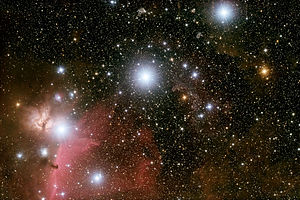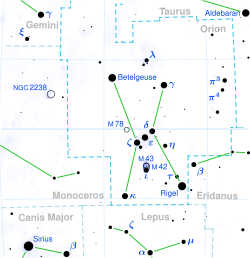Mintaka
| Observation data Epoch J2000 Equinox J2000 | ||
|---|---|---|
| Constellation | Orion | |
| δ Ori A (Aa1 + Aa2 + Ab) | ||
| Right ascension | 05h 32m 00.40009s[1] | |
| Declination | −00° 17′ 56.7424″[1] | |
| Apparent magnitude (V) | 2.23[2] (2.50 + 3.90[3]) | |
| δ Ori B | ||
| Right ascension | 05h 31m 58.745s[4] | |
| Declination | −00° 18′ 18.65″[4] | |
| Apparent magnitude (V) | 14.0[5] | |
| HD 36485 | ||
| Right ascension | 05h 32m 00.406s[6] | |
| Declination | −00° 17′ 04.38″[6] | |
| Apparent magnitude (V) | 6.85[5] | |
| Characteristics | ||
| A | ||
| Spectral type | O9.5II + B1V +B0IV[7] | |
| U−B color index | −1.05[2] | |
| B−V color index | −0.22[2] | |
| Variable type | Eclipsing binary[8]
| |
| C | ||
| Spectral type | B3V + A0V[9] | |
| U−B color index | −0.71[10] | |
| B−V color index | −0.16[10] | |
| Absolute magnitude (MV) | −5.8[5] | |
| δ Ori Aa1 | ||
| Absolute magnitude (MV) | −5.4[5] | |
| δ Ori Aa2 | ||
| Absolute magnitude (MV) | −2.9[5] | |
| δ Ori Ab | ||
| Absolute magnitude (MV) | −4.2[5] | |
| HD 36485 | ||
Distance | 1,240 ± 30 ly (381 ± 8 pc) | |
Argument of periastron (ω)(secondary) | 141.3±0.2° | |
Argument of periastron (ω)(secondary) | 259±2° | |
| Details | ||
| δ Ori Aa1 | ||
Rotational velocity (v sin i) | 150±50[7] km/s | |
| δ Ori Ab | ||
Rotational velocity (v sin i) | 220±20[7] km/s | |
| δ Ori B | ||
| Radius | 0.77[14] R☉ | |
| Luminosity | 0.431[14] L☉ | |
| Temperature | 5,324[14] K | |
| HD 36485 | ||
| Mass | 6-11[15] M☉ | |
| Radius | 5.7[16] R☉ | |
| Luminosity | 3,300[16] L☉ | |
| Surface gravity (log g) | 4.41[16] cgs | |
| Temperature | 18,400[16] K | |
CCDM J05320-0018C | ||
| Database references | ||
| SIMBAD | data | |
| δ Ori B | ||
| HD 36485 | ||
Mintaka /ˈmɪntəkə/,[17] designation Delta Orionis (δ Orionis, abbreviated Delta Ori, δ Ori) and 34 Orionis (34 Ori), is a multiple star system some 1,200 light-years from the Sun in the constellation of Orion. Together with Alnitak (Zeta Orionis) and Alnilam (Epsilon Orionis), the three stars form Orion's Belt, known by many names among ancient cultures. The star is located very close to the celestial equator. When Orion is near the meridian, Mintaka is the rightmost of the Belt's stars when viewed from the Northern Hemisphere facing south.
Nomenclature
Delta Orionis is the star's
Observational history
Mintaka is the westernmost of the three stars of Orion's belt. It is easily visible to the naked eye, one of the
System
δ Orionis is a

The primary component is itself a triple system: a
The outer star of the triple system orbits the inner pair once every 53,839 days (147.40 yr). The orbit is quite eccentric, with the separation varying between 8,244 solar radii (38.34 au) and 31,832 solar radii (148.03 au).[9]
The seventh-magnitude companion, HD 36485, is a
The 14th-magnitude companion is thought to be around the same distance and is a somewhat cooler and less luminous star than the Sun.[14]
Mintaka is surrounded by a cluster of faint stars, possibly part of the cluster surrounding
Distance
The distance derived from the
The Gaia DR3 parallax for component B is 3.5002″±0.0119″, strongly suggesting it is considerably closer than the other members of the system and merely a chance alignment.
Etymology and cultural significance
Mintaka was seen by astrologers as a portent of good fortune.[18]
Orion's Belt

The three belt stars were collectively known by many names in many cultures. Arabic terms include Al Nijād 'the Belt', Al Nasak 'the Line', Al Alkāt 'the Golden Grains or Nuts', and, in modern Arabic, Al Mīzān al Ḥakk 'the Accurate Scale Beam'. In Chinese mythology, they were also known as the Weighing Beam.[citation needed]
In
Namesakes
The
See also
- Mintaka in fiction
References
- ^ S2CID 18759600. Vizier catalog entry
- ^ Bibcode:1991bsc..book.....H.
- ^ .
- ^ Bibcode:2012yCat.1322....0Z.
- ^ S2CID 118957476.
- ^ .
- ^ S2CID 14909574.
- ^ Bibcode:2009yCat....102025S.
- ^ S2CID 256226821.
- ^ .
- S2CID 119387088.
- ^ S2CID 244398875. Gaia DR3 record for this source at VizieR.
- ^ S2CID 17339779.
- ^ .
- ^ .
- ^ Bibcode:1997A&A...324..949Z.
- S2CID 120743052.
- ^ ISBN 1-931559-44-9.
- ^ "IAU Working Group on Star Names (WGSN)". Retrieved 22 May 2016.
- ^ "Bulletin of the IAU Working Group on Star Names, No. 1" (PDF). Retrieved 28 July 2016.
- ^ "IAU Catalog of Star Names". Retrieved 28 July 2016.
- Bibcode:1900Obs....23..148D.
- ^ doi:10.1086/141112.
- doi:10.1086/323920.
- doi:10.1086/159148. Retrieved 14 July 2022.
- S2CID 17089387.
- S2CID 16175953.
- S2CID 244398875. Gaia DR3 record for this source at VizieR.
- ISBN 978-986-7332-25-7
- ^ (in Chinese) AEEA (Activities of Exhibition and Education in Astronomy) 天文教育資訊網 2006 年 5 月 25 日


